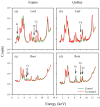Enlightening the Pathway of Phytoremediation: Ecophysiology and X-ray Fluorescence Visualization of Two Chilean Hardwoods Exposed to Excess Copper
- PMID: 35622650
- PMCID: PMC9146126
- DOI: 10.3390/toxics10050237
Enlightening the Pathway of Phytoremediation: Ecophysiology and X-ray Fluorescence Visualization of Two Chilean Hardwoods Exposed to Excess Copper
Abstract
In the present climate emergency due to global warming, we are urged to move away from fossil fuels and pursue a speedy conversion to renewable energy systems. Consequently, copper (Cu) will remain in high demand because it is a highly efficient conductor used in clean energy systems to generate power from solar, hydro, thermal and wind energy across the world. Chile is the global leader in copper production, but this position has resulted in Chile having several hundred tailing deposits. We grew two Chilean native hardwood species, quillay (Quillaja saponaria Molina) and espino (Vachellia caven (Molina) Seigler & Ebinger, under three increasing Cu levels (0, 50, and 100 µM) for 6 months in a greenhouse setting. We measured growth, photosynthetic performance and elemental contents of leaves and roots to further evaluate their potential for phytoremediation. Growth of quillay was unaffected by Cu treatment but growth of espino was enhanced, as was its photosynthetic performance, indicating that espino may have an unusually high requirement for copper. Excess Cu was mostly restricted to the roots of both species, where X-ray fluorescence (XRF) mapping indicated some tendency for Cu to accumulate in tissues outside the periderm. Calcium oxalate crystals were prominently visible in XRF images of both species. Nickel (but not Cu) showed a concurrent distribution pattern with these crystals.
Keywords: Chile; native species; photosynthesis; synchrotron radiation; tailings.
Conflict of interest statement
The authors declare no conflict of interest.
Figures









Similar articles
-
Growth response, uptake and mobilization of metals in native plant species on tailings at a Chilean copper mine.Int J Phytoremediation. 2021;23(5):539-547. doi: 10.1080/15226514.2020.1838435. Epub 2020 Nov 3. Int J Phytoremediation. 2021. PMID: 33142078
-
Cadmium and Copper Stress Responses in Soapbark Tree (Quillaja saponaria): Effects on Growth, Metal Accumulation, Saponin Concentration, and Gene Expression.Plants (Basel). 2025 Feb 26;14(5):709. doi: 10.3390/plants14050709. Plants (Basel). 2025. PMID: 40094634 Free PMC article.
-
Heavy metal bioaccumulation and morphological changes in Vachellia campechiana (Fabaceae) reveal its potential for phytoextraction of Cr, Cu, and Pb in mine tailings.Environ Sci Pollut Res Int. 2020 Apr;27(10):11260-11276. doi: 10.1007/s11356-020-07730-7. Epub 2020 Jan 20. Environ Sci Pollut Res Int. 2020. PMID: 31960245
-
Germination rates of four Chilean forest trees seeds: Quillaja saponaria, Prosopis chilensis, Vachellia caven, and Caesalpinia spinosa.F1000Res. 2018 Sep 10;7:1446. doi: 10.12688/f1000research.16091.1. eCollection 2018. F1000Res. 2018. PMID: 30542617 Free PMC article.
-
Photochemical conversion of solar energy.ChemSusChem. 2008;1(1-2):26-58. doi: 10.1002/cssc.200700087. ChemSusChem. 2008. PMID: 18605661 Review.
References
-
- IPCC . Summary for Policymakers. In: Masson-Delmotte V., Zhai P., Pirani A., Connors S.L., Péan C., Berger S., Caud N., Chen Y., Goldfarb L., Gomis M.I., et al., editors. Climate Change 2021: The Physical Science Basis. Contribution of Working Group I to the Sixth Assessment Report of the Intergovernmental Panel on Climate Change. 1st ed. Cambridge University Press; Cambridge, UK: 2021. in press .
-
- Muñoz-Sáez A., Choe H., Boynton R.M., Elsen P.R., Thorne J.H. Climate exposure shows high risk and few climate refugia for Chilean native vegetation. Sci. Total Environ. 2021;785:147399. doi: 10.1016/j.scitotenv.2021.147399. - DOI
-
- PUCV. [(accessed on 24 February 2022)]. Available online: https://www.pucv.cl/uuaa/vriea/noticias/nuestros-investigadores/en-chile....
-
- DatosGob. [(accessed on 11 September 2021)]; Available online: https://datos.gob.cl/dataset/ley-promedio-de-mineral-de-cobre-en-las-ope....
LinkOut - more resources
Full Text Sources

